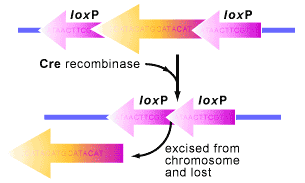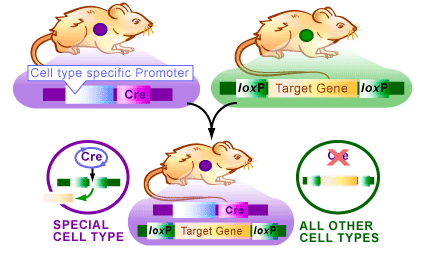

|
MOLECULAR & CELLULAR
NEUROBIOLOGY - NEUROGENOMICS
Master Course Cognitive Neuroscience - Radboud
University, Nijmegen
Chapter 4: Genomics |
|
Conditional knock-out/knock-in in Neuroscience |
|
The Cre/lox system for generating conditional knock-out mice (produce a mouse that no longer has a target gene in only one cell type) has been used as a way to artificially control gene expression. The system concerns a clever way to move pieces of DNA around in a cell (see figures below). Over the years, this system has allowed researchers to create a variety of genetically modified animals with the gene of their choice being externally regulated. This has contributed to our understanding of how individual genes and proteins work. Example: serotonin is implicated in mood regulation, and drugs acting via the serotonergic system are effective in treating anxiety and depression. Specifically, agonists of the serotonin-1A receptor have anxiolytic properties, and knockout mice lacking this receptor show increased anxiety-like behaviour. A tissue-specific, conditional rescue strategy was used to show that expression of the serotonin-1A receptor primarily in the hippocampus and cortex, but not in the raphe nuclei, is sufficient to rescue the behavioural phenotype of the knockout mice. Furthermore, using the conditional nature of these transgenic mice, receptor expression during the early postnatal period, but not in the adult, appeared to be necessary for this behavioural rescue. Thus, postnatal developmental processes help to establish adult anxiety-like behaviour. See also under "Molecular biological research methodology - Gene transfer".
|
|
|
|
|
| A model of Cre function. The loxP sites recognized by Cre are represented with thick arrows and their DNA sequence is shown at the bottom. |
Cre/lox Mouse Breeding. Mice with the Cre protein expressing in a specific
cell type are bred with mice that contain a target gene surrounded by
loxP
sites. When the mice are bred, the cells carrying Cre will cause those
cells to lose the target gene.
|
|
| Next page: Molecular biology and genetics | Go back to: Genetic variations: SNPs and CNVs |